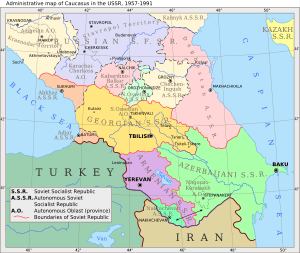North Ossetia–Alania
The Republic of North Ossetia – Alania (Russian: Республика Северная Осетия — Алания, tr. Respublika Severnaya Osetiya — Alaniya, IPA: [rʲɪˈspublʲɪkə ˈsʲevʲɪrnəjə ɐˈsʲetʲɪjə ɐˈlanʲɪjə]; Ossetian: Республикӕ Цӕгат Ирыстон — Алани, Respublike Tsegat Irêšton — Alani, Ossetian pronunciation: [resˈpublikə t͡səˈgät iɾɨˈʃton äˈläni] ![]()
Republic of North Ossetia – Alania | |
|---|---|
| Республика Северная Осетия — Алания | |
| Other transcription(s) | |
| • Ossetian | Республикӕ Цӕгат Ирыстон — Алани |
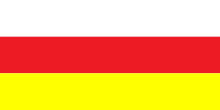 Flag 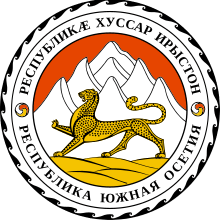 Coat of arms | |
| Anthem: State Anthem of the Republic of North Ossetia–Alania[1] | |
.svg.png) | |
| Coordinates: 43°11′N 44°14′E | |
| Country | Russia |
| Federal district | North Caucasian[2] |
| Economic region | North Caucasus[3] |
| Established | 5 December 1936[4] |
| Capital | Vladikavkaz[5] |
| Government | |
| • Body | Parliament[6] |
| • Head[6] | Vyacheslav Bitarov[7] |
| Area | |
| • Total | 8,000 km2 (3,000 sq mi) |
| Area rank | 79th |
| Population (2010 Census)[9] | |
| • Total | 712,980 |
| • Estimate (2018)[10] | 701,765 (-1.6%) |
| • Rank | 65th |
| • Density | 89/km2 (230/sq mi) |
| • Urban | 63.8% |
| • Rural | 36.2% |
| Time zone | UTC+3 (MSK |
| ISO 3166 code | RU-SE |
| License plates | 15 |
| OKTMO ID | 90000000 |
| Official languages | Russian;[12] Ossetian[13] |
| Website | http://www.rso-a.ru |
Name
In the last years of the Soviet Union, as nationalist movements swept throughout the Caucasus, many intellectuals in the North Ossetian ASSR called for the revival of the name of Alania, a medieval kingdom of the Alans. The term of "Alania" quickly became popular in Ossetian daily life through the names of various enterprises, a TV channel, political and civic organizations, publishing house, football team, etc. In November 1994, the name of "Alania" was officially added to the republic's title (Republic of North Ossetia – Alania).[14]
Geography
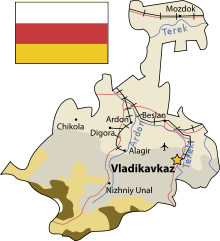
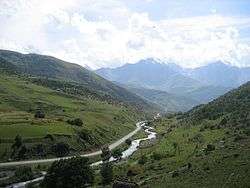
The republic is located in the North Caucasus. The northern part of the republic is situated in the Stavropol Plain. 22% of the republic's territory is covered by forests.
- Area: 8,000 square kilometers (3,100 sq mi)
- Borders:
- internal: Kabardino-Balkaria (W/NW/N), Stavropol Krai (N), Chechnya (NE/E), Ingushetia (E/SE)
- international: Georgia (including South Ossetia; Mtskheta-Mtianeti, Racha-Lechkhumi and Kvemo Svaneti and Shida Kartli) (SE/S/SW)
- Highest point: Mount Kazbek (5,033 meters (16,512 ft))
- Maximum north-south distance: 130 kilometers (81 mi)
- Maximum east-west distance: 120 kilometers (75 mi)
Rivers
All of the republic's rivers belong to the drainage basin of the Terek River. Major rivers include:
- Terek River (~600 km)
- Urukh River (104 km)
- Ardon River (101 km)
- Kambileyevka River (99 km)
- Gizeldon River (81 km)
- Fiagdon River
- Sunzha River (278 km)
Mountains
All of the mountains located on the territory of the republic are a part of the Caucasus. Mount Kazbek is the highest point (5,033 m), with Mount Dzhimara being the second-highest (4,780 m).
Natural resources
Natural resources include minerals (copper, silver, zinc), timber, mineral waters, hydroelectric power, and untapped reserves of oil and gas.
Climate
The climate is moderately continental.
- Average January temperature: −5 °C (23 °F)
- Average July temperature: +24 °C (75 °F)
- Average annual precipitation: 400–700 millimeters (16–28 in) in the plains; over 1,000 millimeters (39 in) in the mountains.
History
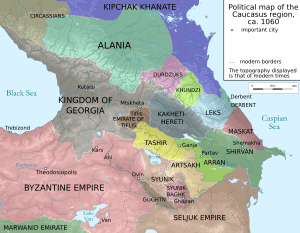
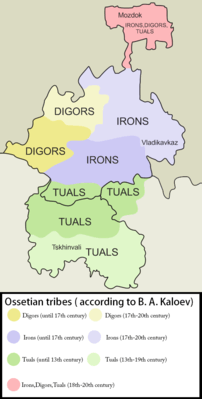
Early history
The territory of North Ossetia was first inhabited by Caucasian tribes. Some Nomadic Alans settled in the region in the 7th century, forming the kingdom of Alania. It was eventually converted to Christianity by missionaries from Byzantium. Alania greatly profited from the Silk Road which passed through its territory.
After the Middle Ages, the Mongols' and Tartars' repeated invasions decimated the population, now known as the Ossetians. Islam was introduced to the region in the 17th century by Kabardians. Conflicts between the Khanate of Crimea and the Ottoman Empire eventually pushed Ossetia into an alliance with Imperial Russia in the 18th century. Soon, Russia established a military base in the capital, Vladikavkaz, making it the first Russian-controlled area in the northern Caucasus. By 1806, Ossetia was under complete Russian control.
Russian/Soviet rule
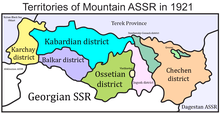
The Russians' rule led to rapid development of industry and railways which overcame its isolation. The first books from the area came during the late 18th century, and became part of the Terskaya Region of Russia in the mid-19th century.
The Russian Revolution of 1917 resulted in North Ossetia being merged into the Mountain Autonomous Soviet Socialist Republic in 1921. It then became the North Ossetian Autonomous Oblast on 7 July 1924, then merged into the North Ossetian Autonomous Soviet Socialist Republic on 5 December 1936. In World War II, it was subject to a number of attacks by Nazi German invaders unsuccessfully trying to seize Vladikavkaz in 1942.
The North Ossetian ASSR declared itself the autonomous republic of the Soviet Union on 20 June 1990. Its name was changed to the Republic of North Ossetia – Alania in 1994.
The dissolution of the Soviet Union posed particular problems for the Ossetian people, who were divided between North Ossetia, which was part of the Russian SFSR, and South Ossetia, part of the Georgian SSR. In December 1990, the Supreme Soviet of Georgia abolished the autonomous Ossetian enclave amid the rising ethnic tensions in the region, which was further fanned by the Moscow; a lot of the conflict zone population, faced with the ethnic genocide, was forced to flee across the border to either North Ossetia or Georgia proper. Some 70,000 South Ossetian refugees were resettled in North Ossetia. North Ossetia provoked the predominantly Ingush population in the Prigorodny District, which sparked the Ossetian–Ingush conflict. The results of the conflict were that 7,000 Ossetians and 64,000 Ingush refugees had to flee their homes.[16] As well as dealing with the effects of the conflict in South Ossetia, North Ossetia has had to deal with refugees and the occasional spillover of fighting from the wars around them. On 23 March 1995, North Ossetia–Alania signed a power-sharing agreement with the federal government, granting it autonomy.[17] This agreement would be abolished on 2 September 2002.[18]
Administrative divisions
Economy
In recent years, North Ossetia – Alania's economic development has been successful; the indicators of the republic's social and economic development between 2005 and 2007 revealed a stable growth of all sectors of the economy and major social parameters. The nature and climatic conditions of the republic contribute to the successful development of various economic sectors, which is compounded by the abundance of natural resources. Gross regional product pro capita of the region in 2006 was 61,000 rubles ($2,596) and increased 30% in the 2005–2007 time period.[19] GRP pro capita in 2007 was 76,455 rubles.[20] From 2005 to 2007, the average monthly wage in North Ossetia – Alania doubled, with the actual cash earnings increased by 42.5 percent. In terms of the average monthly wage growth, the Republic ranks first in the North Caucasus.[19]
The regional government's economic priorities include industrial growth, development of small enterprise, spas, and resorts, and strengthening the budgetary and tax discipline.[21]
The largest companies in the region include Elektrozinc, Sevkavkazenergo, Pobedit (tungsten and molybdenum producer).[22]
Natural resources, agriculture, and industry
The most widespread resources are zinc- and lead-containing complex ores. There are deposits of limestone, dolomites, marble, and touchstone. There is also a large availability of construction materials, such as clay, sand, and gravel. The local oil deposit reserves are estimated at 10 million metric tons.[19]
The agricultural sector is varied and specializes in the cultivation of wheat, corn, and sunflowers; horticulture; viticulture; and cattle and sheep breeding.[23][24]
North Ossetia's industry is mainly concentrated in Vladikavkaz. Major companies located here include Elektrotsink, Gazoapparat, an instrument-making plant, Elektrokontraktor, a factory producing automotive electrical equipment, a large-panel construction complex, and companies in the food industry. The Sadonsky industrial center has grown around the mining and forest industries.[24]
Tourism
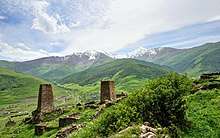
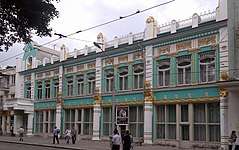
Despite the proximity to Chechnya, North Ossetia is making efforts to develop its tourist industry.[25] Projects under a program for spa, resort, and tourism development have been successfully implemented in the mountainous part of the republic, according to the head of the regional government.[21] There are nearly 3,000 historical monuments in the Republic and more than half of its area is occupied by Alania National Park, the North Ossetia National Preserve, and game preserves. There are more than 250 therapeutic, mineral, and freshwater springs in the republic with estimated daily reserves of 15,000 cubic meters. Besides providing the basis for health spas, these mineral waters also have the potential to be bottled and sold. North Ossetian mineral waters are known for their unique qualities, as well as special mineral composition.[24][25]
Infrastructure
In terms of its infrastructure, North Ossetia – Alania ranks second in the Southern Federal District and 10th in the nation.[19] The republic has some of the most extensive telecommunication networks in the North Caucasus region and in Russia. It ranks first in terms of its telecom network installations in the Southern Federal District.
The republic ranks fourth in Russia in terms of its paved roads, and its expanding transport and logistics complex provides communication networks between Russia and the South Caucasus, as well as Central Asia. The complex includes two federal highways (Georgian Military Road connects Vladikavkaz with Transcaucasia) running across the Greater Caucasus Range, two customs checkpoints for cars, a developed railway network, Vladikavkaz international airport, and well-equipped transport terminals.[19]
Demographics
Population: 712,980 (2010 Census);[9] 710,275 (2002 Census);[26] 634,009 (1989 Census).[27]
Number of refugees: 12,570[28]
Settlements
Vital statistics
| Average population (1000s) | Live births | Deaths | Natural change | Crude birth rate (per 1000) | Crude death rate (per 1000) | Natural change (per 1000) | Fertility rates | |
|---|---|---|---|---|---|---|---|---|
| 1970 | 554 | 9,731 | 3,964 | 5,767 | 17.6 | 7.2 | 10.4 | |
| 1975 | 575 | 10,368 | 4,664 | 5,704 | 18.0 | 8.1 | 9.9 | |
| 1980 | 598 | 10,135 | 5,821 | 4,314 | 16.9 | 9.7 | 7.2 | |
| 1985 | 617 | 11,598 | 6,047 | 5,551 | 18.8 | 9.8 | 9.0 | |
| 1990 | 649 | 10,967 | 6,166 | 4,801 | 16.9 | 9.5 | 7.4 | 2.23 |
| 1991 | 679 | 10,985 | 6,694 | 4,291 | 16.2 | 9.9 | 6.3 | 2.09 |
| 1992 | 683 | 10,048 | 7,125 | 2,923 | 14.7 | 10.4 | 4.3 | 1.89 |
| 1993 | 661 | 8,251 | 7,872 | 379 | 12.5 | 11.9 | 0.6 | 1.67 |
| 1994 | 666 | 8,806 | 8,329 | 477 | 13.2 | 12.5 | 0.7 | 1.79 |
| 1995 | 674 | 8,781 | 8,574 | 207 | 13.0 | 12.7 | 0.3 | 1.78 |
| 1996 | 680 | 8,043 | 8,514 | −471 | 11.8 | 12.5 | −0.7 | 1.62 |
| 1997 | 681 | 7,758 | 8,378 | −620 | 11.4 | 12.3 | −0.9 | 1.56 |
| 1998 | 683 | 7,767 | 8,188 | −421 | 11.4 | 12.0 | −0.6 | 1.56 |
| 1999 | 689 | 7,195 | 8,412 | −1,217 | 10.4 | 12.2 | −1.8 | 1.43 |
| 2000 | 699 | 7,179 | 8,626 | −1,447 | 10.3 | 12.3 | −2.0 | 1.39 |
| 2001 | 707 | 7,317 | 8,205 | −888 | 10.3 | 11.6 | −1.3 | 1.39 |
| 2002 | 709 | 7,874 | 8,753 | −879 | 11.1 | 12.3 | −1.2 | 1.47 |
| 2003 | 709 | 7,978 | 8,952 | −974 | 11.3 | 12.6 | −1.4 | 1.48 |
| 2004 | 707 | 7,893 | 8,663 | −770 | 11.2 | 12.2 | −1.1 | 1.46 |
| 2005 | 706 | 7,894 | 8,654 | −760 | 11.2 | 12.3 | −1.1 | 1.46 |
| 2006 | 706 | 8,308 | 8,138 | 170 | 11.8 | 11.5 | 0.2 | 1.53 |
| 2007 | 706 | 9,556 | 7,806 | 1,750 | 13.5 | 11.1 | 2.5 | 1.76 |
| 2008 | 708 | 9,981 | 7,975 | 2,006 | 14.1 | 11.3 | 2.8 | 1.83 |
| 2009 | 710 | 10,017 | 7,987 | 2,030 | 14.1 | 11.3 | 2.9 | 1.84 |
| 2010 | 712 | 10,303 | 7,748 | 2,555 | 14.5 | 10.8 | 3.7 | 1.88 |
| 2011 | 715 | 10,375 | 7,720 | 2,655 | 14.5 | 10.8 | 3.7 | 1.88 |
| 2012 | 708 | 10,801 | 7,525 | 3,276 | 15.3 | 10.6 | 4.7 | 1.96 |
| 2013 | 705 | 10,760 | 7,394 | 3,366 | 15.3 | 10.5 | 4.8 | 1.98 |
| 2014 | 705 | 10,798 | 7,554 | 3,244 | 15.3 | 10.7 | 4.6 | 2.01 |
| 2015 | 704 | 10,341 | 7,558 | 2,783 | 14.6 | 10.7 | 3.9 | 1.93 |
| 2016 | 704 | 9,916 | 7,296 | 2,620 | 14.1 | 10.3 | 3.8 | 1.89(est.) |
| 2017 | 702 | 8,992 | 7,151 | 1,841 | 12.8 | 10.2 | 2.6 |
Ethnic groups
The majority of the population of North Ossetia are Christians who belong to the Russian Orthodox Church, although there is also a Muslim minority who are of Ossetian-speaking origin.
According to the 2010 Census,[9] Ossetians make up 65.1% of the republic's population. Other groups include Russians (20.8%), Ingush (4.0%), Armenians (2.3%), Kumyks (2.3%), Georgians (1.3%), Ukrainians (0.4%), Chechens (0.3%), and Caucasus Greeks (0.2%).
| Ethnic group |
1926 Census1 | 1939 Census | 1959 Census | 1970 Census | 1979 Census | 1989 Census | 2002 Census | 2010 Census2 | ||||||||
|---|---|---|---|---|---|---|---|---|---|---|---|---|---|---|---|---|
| Number | % | Number | % | Number | % | Number | % | Number | % | Number | % | Number | % | Number | % | |
| Ossetians | 141,723 | 49.6% | 165,616 | 50.3% | 215,463 | 47.8% | 269,326 | 48.7% | 299,022 | 50.5% | 334,876 | 53.0% | 445,310 | 62.7% | 459,688 | 65.1% |
| Russians | 68,192 | 23.8% | 122,614 | 37.2% | 178,654 | 39.6% | 202,367 | 36.6% | 200,692 | 33.9% | 189,159 | 29.9% | 164,734 | 23.2% | 147,090 | 20.8% |
| Ingush | 23,851 | 8.3% | 6,106 | 1.9% | 6,071 | 1.3% | 18,387 | 3.3% | 23,663 | 4.0% | 32,783 | 5.2% | 21,442 | 3.0% | 28,336 | 4.0% |
| Armenians | 9,185 | 3.2% | 8,932 | 2.7% | 12,012 | 2.7% | 13,355 | 2.4% | 12,912 | 2.2% | 13,619 | 2.2% | 17,147 | 2.4% | 16,235 | 2.3% |
| Kumyks | 3,153 | 1.1% | 85 | 0.0% | 3,921 | 0.9% | 6,363 | 1.2% | 7,610 | 1.3% | 9,478 | 1.5% | 12,659 | 1.8% | 16,092 | 2.3% |
| Georgians | 6,057 | 2.1% | 6,312 | 1.9% | 8,160 | 1.8% | 10,323 | 1.9% | 11,347 | 1.9% | 12,284 | 1.9% | 10,803 | 1.5% | 9,095 | 1.3% |
| Ukrainians | 19,101 | 6.7% | 7,063 | 2.1% | 9,362 | 2.1% | 9,250 | 1.7% | 10,574 | 1.8% | 10,088 | 1.6% | 5,198 | 0.7% | 3,251 | 0.4% |
| Others | 14,690 | 5.1% | 12,477 | 3.8% | 16,938 | 3.8% | 23,210 | 4.2% | 26,182 | 4.4% | 30,141 | 4.8% | 32,982 | 4.6% | 26,636 | 3.8% |
| 1 The results of the 1926 census refer to the present territory, which is a combination of the North Ossetian AO, the city of Vladikavkaz and adjacent areas.[29]
2 6,557 people were registered from administrative databases, and could not declare an ethnicity. It is estimated that the proportion of ethnicities in this group is the same as that of the declared group.[30] | ||||||||||||||||
Languages
There are two official languages in North Ossetia – Russian, which is official in all Russian territory, and Ossetian. Ossetian is an Indo-European language, belonging to the East Iranian group. Russian, acting as a lingua franca in the region, is an East Slavic language and as such also belongs to the Indo-European family, which means the two languages are related, albeit distantly.
Religion
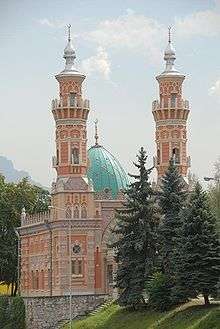
According to a 2012 survey which interviewed 56,900 people,[31] 49% of the population of North Ossetia – Alania adheres to the Russian Orthodox Church, 10% declare to be unaffiliated Christian believers, 2% are either Orthodox Christian believers who do not belong to churches or members of non-Russian Orthodox bodies. The second-largest religion is Ossetian ethnic religion, generally called Uatsdin (Уацдин, "True Faith"), a Scythian religion organized into movements such as the Atsætæ Church, comprising 29% of the population. Muslims constitute 4% of the population, and Protestants the 1%. In addition, 1% of the population declares to be "spiritual but not religious" and 3% to be atheist.[31]
According to a 2013 estimate, up to 15% of North Ossetia’s population practice Islam.[33]
Politics
During the Soviet period, the high authority in the republic was shared between three people; the first secretary of the North Ossetia Communist Party of the Soviet Union (CPSU) Committee (who in reality had the biggest authority), the chairman of the oblast Soviet (legislative power), and the Chairman of the Republic Executive Committee (executive power). Since 1991, CPSU lost all the power, and the head of the Republic administration, and eventually the governor was appointed/elected alongside elected regional parliament.
The Charter of the Republic of North Ossetia – Alania is the fundamental law of the region. The Parliament of North Ossetia–Alania is the republic's regional standing legislative (representative) body. The Legislative Assembly exercises its authority by passing laws, resolutions, and other legal acts and by supervising the implementation and observance of the laws and other legal acts passed by it. The highest executive body is the Republic's Government, which includes territorial executive bodies such as district administrations, committees, and commissions that facilitate development and run the day to day matters of the province. The Oblast administration supports the activities of the Governor who is the highest official and acts as guarantor of the observance of the krai Charter in accordance with the Constitution of Russia.
The head of government in the Republic of North Ossetia – Alania is the Head of the Republic. As of 2008, the head of the republic is Taymuraz Mamsurov. Mamsurov succeeded Alexander Dzasokhov, who voluntarily quit his post on 31 May 2005.[34]
Education
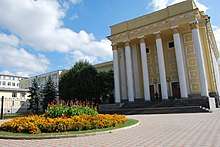
The most important facilities of higher education include North Caucasus State Technological University, North Ossetian State University, North Ossetian State Medical Academy, and Mountain State Agrarian University—all in Vladikavkaz.
Culture
There are six professional theaters in North Ossetia – Alania, as well as Ossetian State Philharmonia.
See also
References
Notes
- Law #520A
- Президент Российской Федерации. Указ №849 от 13 мая 2000 г. «О полномочном представителе Президента Российской Федерации в федеральном округе». Вступил в силу 13 мая 2000 г. Опубликован: "Собрание законодательства РФ", No. 20, ст. 2112, 15 мая 2000 г. (President of the Russian Federation. Decree #849 of May 13, 2000 On the Plenipotentiary Representative of the President of the Russian Federation in a Federal District. Effective as of May 13, 2000.).
- Госстандарт Российской Федерации. №ОК 024-95 27 декабря 1995 г. «Общероссийский классификатор экономических регионов. 2. Экономические районы», в ред. Изменения №5/2001 ОКЭР. (Gosstandart of the Russian Federation. #OK 024-95 December 27, 1995 Russian Classification of Economic Regions. 2. Economic Regions, as amended by the Amendment #5/2001 OKER. ).
- North Ossetian ASSR, of which the modern Republic of North Ossetia – Alania is a direct successor, was established as a separate entity within the Russian SFSR upon the adoption of the 1936 Soviet Constitution
- Constitution of the Republic of North Ossetia – Alania, Article 64
- Constitution of the Republic of North Ossetia – Alania, Article 7
- Official website of the Head of the Republic of North Ossetia–Alania. Vyacheslav Zelimkhanovich Bitarov, Acting Head of the Republic of North Ossetia – Alania (in Russian)
- Федеральная служба государственной статистики (Federal State Statistics Service) (21 May 2004). "Территория, число районов, населённых пунктов и сельских администраций по субъектам Российской Федерации (Territory, Number of Districts, Inhabited Localities, and Rural Administration by Federal Subjects of the Russian Federation)". Всероссийская перепись населения 2002 года (All-Russia Population Census of 2002) (in Russian). Federal State Statistics Service. Retrieved 1 November 2011.
- Russian Federal State Statistics Service (2011). "Всероссийская перепись населения 2010 года. Том 1" [2010 All-Russian Population Census, vol. 1]. Всероссийская перепись населения 2010 года [2010 All-Russia Population Census] (in Russian). Federal State Statistics Service.
- "26. Численность постоянного населения Российской Федерации по муниципальным образованиям на 1 января 2018 года". Federal State Statistics Service. Retrieved 23 January 2019.
- "Об исчислении времени". Официальный интернет-портал правовой информации (in Russian). 3 June 2011. Retrieved 19 January 2019.
- Official throughout the Russian Federation according to Article 68.1 of the Constitution of Russia.
- Constitution of the Republic of North Ossetia – Alania, Article 15
- Shnirelman, Victor (2006). The Politics of a Name: Between Consolidation and Separation in the Northern Caucasus. Acta Slavica Iaponica 23, pp. 37–49.
- "Archived copy". Archived from the original on 5 February 2017. Retrieved 4 February 2017.CS1 maint: archived copy as title (link)
- https://www.hrw.org/legacy/reports/1996/Russia.htm
- Solnick, Steven (29 May 1996). "Asymmetries in Russian Federation Bargaining" (PDF). The National Council for Soviet and East European Research: 12. Archived from the original (PDF) on 28 August 2017. Retrieved 6 May 2019.
- Chuman, Mizuki. "The Rise and Fall of Power-Sharing Treaties Between Center and Regions in Post-Soviet Russia" (PDF). Demokratizatsiya: 146.
- "North Ossetia–Alania: social and economic indicators looking up". Moscow News. 18 September 2008. Archived from the original on 4 March 2009. Retrieved 30 August 2008.
- Валовой региональный продукт на душу населения Федеральная служба государственной статистики
- "Republic of North Ossetia–Alania: Introduction". Russia: All Regions Trade & Investment Guide. CTEC Publishing LLC. 2008. Archived from the original on 15 July 2011.
- Выписки ЕГРЮЛ и ЕГРИП, проверка контрагентов, ИНН и КПП организаций, реквизиты ИП и ООО. СБИС (in Russian). Retrieved 20 October 2018.
- "North Ossetia–Alania". Microsoft Encarta. Archived from the original on 1 November 2009. Retrieved 4 June 2009.
- "Republic of North Ossetia". Kommersant. 11 March 2004. Archived from the original on 5 January 2009. Retrieved 4 June 2009.
- "Republic of North Ossetia". Russia Profile. 25 August 2008. Archived from the original on 4 December 2008. Retrieved 4 June 2009.
- Russian Federal State Statistics Service (21 May 2004). "Численность населения России, субъектов Российской Федерации в составе федеральных округов, районов, городских поселений, сельских населённых пунктов – районных центров и сельских населённых пунктов с населением 3 тысячи и более человек" [Population of Russia, Its Federal Districts, Federal Subjects, Districts, Urban Localities, Rural Localities—Administrative Centers, and Rural Localities with Population of Over 3,000] (XLS). Всероссийская перепись населения 2002 года [All-Russia Population Census of 2002] (in Russian).
- "Всесоюзная перепись населения 1989 г. Численность наличного населения союзных и автономных республик, автономных областей и округов, краёв, областей, районов, городских поселений и сёл-райцентров" [All Union Population Census of 1989: Present Population of Union and Autonomous Republics, Autonomous Oblasts and Okrugs, Krais, Oblasts, Districts, Urban Settlements, and Villages Serving as District Administrative Centers]. Всесоюзная перепись населения 1989 года [All-Union Population Census of 1989] (in Russian). Институт демографии Национального исследовательского университета: Высшая школа экономики [Institute of Demography at the National Research University: Higher School of Economics]. 1989 – via Demoscope Weekly.
- В 2008 году естественный прирост населения Северной Осетии составил более 2 тыс. человек – Новости России – ИА REGNUM. Regnum.ru (26 February 2009). Retrieved on 18 August 2012.
- население северной осетии. Ethno-kavkaz.narod.ru. Retrieved on 18 August 2012.
- Перепись-2010: русских становится больше. Perepis-2010.ru (19 December 2011). Retrieved on 18 August 2012.
- "Arena: Atlas of Religions and Nationalities in Russia". Sreda, 2012.
- 2012 Arena Atlas Religion Maps. "Ogonek", № 34 (5243), 27/08/2012. Retrieved 21 April 2017. Archived.
- "Ossetians in Georgia, with their backs to the mountains".
- "Regional government to quit over Beslan tragedy: president". ABC News.
Sources
- Парламент Республики Северная Осетия — Алания. Закон №520А от 24 ноября 1994 г. «О государственном гимне Республики Северная Осетия — Алания», в ред. Закона №44-РЗ от 31 июля 2006 г «О внесении изменений в Закон Республики Северная Осетия — Алания "О государственном гимне Республики Северная Осетия — Алания"». Опубликован: Газета "Северная Осетия". (Parliament of the Republic of North Ossetia – Alania. Law #520A of 14 November 1994 On the State Anthem of the Republic of North Ossetia – Alania, as amended by the Law #44-RZ of 31 July 2006 On Amending the Law of the Republic of North Ossetia – Alania "On the State Anthem of the Republic of North Ossetia – Alania". ).
- Верховный Совет Республики Северная Осетия. 12 ноября 1994 г. «Республика Северная Осетия-Алания. Конституция.», в ред. Конституционного Закона №5-РКЗ от 4 декабря 2013 г. «О внесении изменений в Конституцию Республики Северная Осетия–Алания». Вступил в силу 7 декабря 1994 г. Опубликован: брошюрой "Конституция Республики Северная Осетия–Алания". (Supreme Council of the Republic of North Ossetia. November 12, 1994 Republic of North Ossetia–Alania. Constitution., as amended by the Constitutional Law #5-RKZ of December 4, 2013 On Amending the Constitution of the Republic of North Ossetia–Alania. Effective as of December 7, 1994.).
External links
General
- (in Russian) Official website of the Republic of North Ossetia–Alania
- (in Russian) Official website of the Parliament of the Republic of North Ossetia–Alania
- Russian News Agency Ria Novosty
- (in Russian) Official website of Alexander Dzasokhov
- (in Russian) Ossetia—History, culture, politics, news
- (in Esperanto) Pictures of North Ossetia–Alania
- (in Ossetian) (in Russian) Welcome to North Ossetia (by Toma Kulayeva)
- (in Ossetian) (in Russian) Ossetian history and culture
Education
- (in Russian) North Ossetian State University
- (in Russian) North Ossetian State Medical Academy
- (in Russian) Higher Institute of Management
- Institute of Civilization
_5033_m.%2C_Stefancminda_district.jpg)
